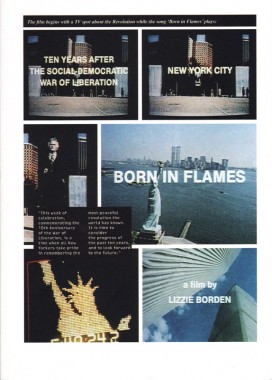
Lizzie Borden, Born in Flames
Softcover, 32 pp., offset 4/4, 210 x 297 mm
Edition of 1000
ISBN 978-0-9562605-9-8
Published by Occasional Papers
$18.00 · out of stock
Born in Flames, the publication, is an illustrated transcript of Lizzie Borden’s 1983 film ‘Born in Flames’, edited and designed by Kaisa Lassinaro. It includes an interview with Borden conducted in Los Angeles by Lassinaro, as well as the lyrics of
Undercover Nation by The Bloods and
Born in Flames by Red Crayola, kindly supplied by Adele Bertei and Mayo Thompson.
‘Born in Flames poses the question of whether oppression against women will be eliminated under any kind of social system. […] It is a fantasy presenting a group of women who, confronted with the very “ordinary” oppression women have been experiencing for decades, refuse to take it any longer and become armed fighters against the government. Their position is that oppression against women is not eliminated automatically with “socialism” — not only do political values have to change, cultural values must change and become embedded in practice.’
— Lizzie Borden in Heresies #16, 1983
In the spirit of Borden’s film, the publication was collectively funded by the following individuals and institutions:
Stuart Bailey, Heather Bradley, Eleanor Brown, Geoffrey Brusatto, Culturgest, Wayne Daly, Chris Evans, Beatrice Gibson, Nick Gordon, The Hawthorne Archive, Erna Hecey, Onno Hesselink, Will Holder, Jeff Khonsary, Koenig Books, Uriel Orlow, Falke Pisano, Philomene Pirecki, PrintRoom: Karin de Jong, Ewoud van Rijn, Pro QM, David Reinfurt, Jane Rolo, Catherine de Smet, Benjamin Thorel, Giulia Vallicelli, and Julia Zay.
Adele Bertei, Anarchy, Beatrice Gibson, Benjamin Thorel, Catherine de Smet, Chris Evans, Culture, Culturgest, David Reinfurt, Distribution, Eleanor Brown, Erna Hecey, Ewoud van Rijn, Falke Pisano, Feminism, Film, Geoffrey Brusatto, Giulia Vallicelli, Heather Bradley, Heresies, Jane Rolo, Jeff Khonsary, Julia Zay, Kaisa Lassinaro, Karin de Jong, Koenig Books, Lizzie Borden, Mayo Thompson, Nick Gordon, Occasional Papers, Onno Hesselink, Philomene Pirecki, PrintRoom, Pro QM, Red Crayola, Sandy Yang, Socialism, Stuart Bailey, The Hawthorne Archive, The Red Krayola, Uriel Orlow, Wayne Daly, Will Holder
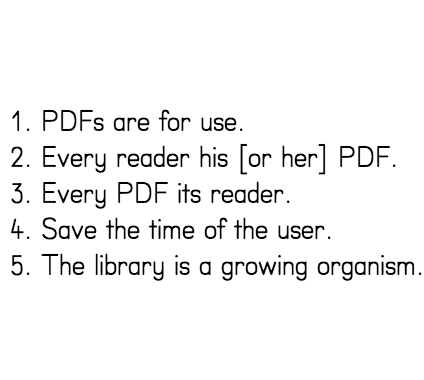
The Serving Library is a collectively-built archive. It consists of three parts: 1. an ambitious public website; 2. a small physical library space; 3. a publishing program which runs both through the website (#1) and through the space (#2). This is a long-term project being developed by Stuart Bailey, Angie Keefer and David Reinfurt. Together we are just beginning so we need your
help to build our library and construct a new model for this old institution.
The first libraries were built on an Archiving model. In the Archiving Library, information and artifacts were collected, concentrated and protected in one central place. On July 1, 1731, Benjamin Franklin established the first Circulating Library in Philadelphia. Books were quite expensive, so by pooling resources many volumes could be shared among contributing members, and, the books moved around. Now, we propose a new model that joins the Archiving Library to the Circulating Library — The Serving Library.
The Serving Library is an archive assembled by publishing. Publishing and archiving have always been either end of a continuous loop, but now on an electronic network like the Internet, the two activities are both simultaneous and indistinguishable. This makes particularly small public libraries increasingly redundant. It’s time to reconsider what kind of library makes sense right now, and suggest one possible way forward.
The Serving Library follows directly from ten years of independently publishing Dot Dot Dot (www.dot-dot-dot.us), a biannual arts journal printed in a run of 3000 copies, with broad international distribution co-founded by Stuart Bailey in 2000. Dot Dot Dot then led to establishing Dexter Sinister (www.dextersinister.org) in 2006, a self-described “Just-in-Time Workshop and Occasional Bookstore” run from a modest basement on the Lower East Side of New York City. Evolving from a publication to a bookstore, we now want to expand from these relatively private activities to a more properly public sphere by developing a new library where materials are collectively produced, assembled and pooled to maintain a body of shared information that serves the committed community who helped make it.
We will build our library by publishing. Bulletins of the Serving Library will be a hybrid electronic / printed publication offered first as PDF files freely available, released in serial form on www.servinglibrary.org. Twice a year, these concise booklets will be collected, printed, bound and distributed. We’re ready to publish the first collection of Bulletins now. This first set directly addresses libraries, archives and collections and includes “An Octopus in Plan View” by Angie Keefer, an 8-part text on communication organized around the anatomy of an octopus; “From O-1: Information on Libraries & From 1-0: Information on Recording” by Rob Giampietro & David Reinfurt, on the paradox of contemporary archiving in the face of the Internet; and “The Life and Death of Media” by Bruce Sterling, an out-of-time plea for compiling an exhaustive list of outdated media formats.
We are asking for your support to help us develop the website, publish the PDFs, print, bind and distribute the first hard-copy issue of the Bulletins and to begin assembling The Serving Library.
www.servinglibrary.org
Angie Keefer, Art, Benjamin Franklin, Bruce Sterling, David Reinfurt, Design, Dexter Sinister, Dot Dot Dot, Libraries, Portable Document Format, Rob Giampietro, Stuart Bailey
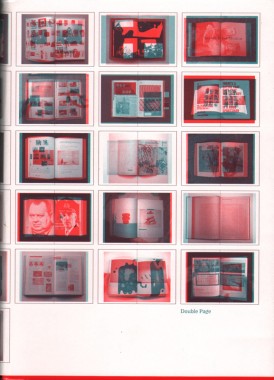
Christoph Keller and Jérôme Saint-Loubert Bié, Double Page
Softcover, 256 pp., offset 4/3, 115 x 160 mm
Edition of 2000
ISBN 978-2917855-06-5
Published by Editions B42
$15.00 · out of stock
45 graphic designers, 90 photographs, 10 years of books on contemporary art.
This book is based on an invitation to graphic designers to choose two books on contemporary art from the past decade whose design they think is particularly pertinent to the content, to photograph one double-page spread from each book and, if they wish, to comment on their choices.
Double Page provides a selection of recent art publications as viewed by graphic designers who are internationally known for their contribution to that field, and offers a glimpse at the role of book design today in our knowledge and understanding of contemporary art.
Shedding light on this prevalent relationship between art and graphic design by means of photography, Double Page constitutes an unprecedented document of how graphic designers see the work of their peers and their own practices as an essential part of the editorial process.
Alberto Vieceli, Alex Rich, Alexandre Dimos, Alexia de Visscher, Armand Mevis, Art, Arthur Herrman, Aude Lehmann, Benjamin Sommerhalder, Caroline Fabès, Catherine de Smet, Change is Good, Christian Haas, Christoph Keller, Christoph Steinegger, Counterspace, Daniel Eatock, David Reinfurt, David Rust, deValence, Dexter Sinister, Dimitri Bruni, Dorothea Weishaupt, École régionale des Beaux-Arts de Rennes, Editions B42, Erik Kessels, Frédéric Teschner, Gaël Étienne, Gail Swanlund, Gavillet & Rust, Georg Rutishauser, Gilles Gavillet, groenlandbasel, Interkool, Jean-Marc Ballée, Jean-Marie Courant, Jeroen Kummer, Jérôme Saint-Loubert Bié, Jocelyn Cottencin, Jon Sueda, Jonathan Maghen, José Albergaria, Joseph Logan, Joséphine Guérin, Julia Born, KesselsKramer, Kummer & Herrman, Lehni-Trueb, Lex Trueb, Lieuxcommuns, Linda van Deursen, Ludovic Balland, Manuel Krebs, Manuel Raeder, Markus Dreßen, Markus Weisbeck, Maureen Mooren, Mevis & van Deursen, Michael Worthington, Mike Meire, Müller & Wesse, NORM, O-R-G, Peter Bilak, Philipp Arnold, Pierre Huyguebaert, Prill & Vieceli, Purtill Family Business, Raffinerie AG für Gestaltung, Regular, Rik Bas Backer, Roger Willems, Roma, Sara De Bondt, Secondary Modern, Simon Josebury, Spector, Speculoos, Stephan Müller, Stripe, Stuart Bailey, Studio Ahoy, Tania Prill, Textfield, Typography Cabinet, Typotheque, Urs Lehni, Warren Olds, Will Holder, Yvonne Quirmbach
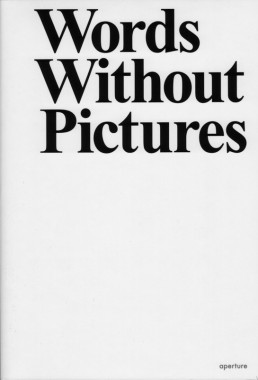
Alex Klein, Words Without Pictures
Softcover, 510 pp., offset 1/1, 5.75 x 8.25 inches
Edition of 2000
ISBN 978-1-5971114-2-3
Published by Aperture/LACMA
$25.00 ·
Words Without Pictures was originally conceived by curator Charlotte Cotton and artist Alex Klein as a means of creating spaces for discourse around current issues in photography. Every month for a year, beginning in November 2007, an artist, educator, critic or curator was invited to contribute a short unillustrated essay about an aspect of emerging photography. Each piece was available on the Words Without Pictures
website for one month and was accompanied by a discussion forum focused on its specific topic. Over the course of its month-long “life,” each essay received both invited and unsolicited responses from a wide range of interested parties. All of these essays, responses and other provocations are gathered together here. Previously issued as a print-on-demand title, we are pleased to present
Words Without Pictures to the trade for the first time as part of the
Aperture Ideas series.
A. L. Steiner, Alex Klein, Alex Slade, Allan McCollum, Allen Ruppersberg, Amir Zaki, Amy Adler, Anthony Pearson, Aperture, Art, Arthur Ou, Carter Mull, Charlie White, Charlotte Cotton, Christopher Bedford, Criticism, DAP, Darius Himes, David Reinfurt, Dexter Sinister, George Baker, Harrell Fletcher, James Welling, Jason Evans, John Divola, Kevin Moore, LACMA, Leslie Hewitt, Marisa Olson, Mark Wyse, Michael Queenland, Miranda Lichtenstein, Paul Graham, Penelope Umbrico, Photography, Sarah Charlesworth, Shannon Ebner, Sharon Lockhart, Soo Kim, Sze Tsung Leong, Theory, Walead Beshty, Wallis Annenberg Photography Department
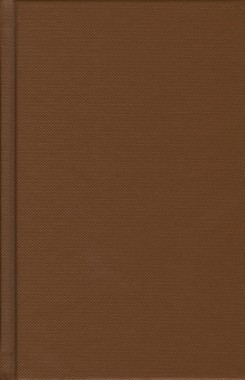
Dexter Sinister, Portable Document Format
Hardcover, 200 pp., offset 4/1, 4.25 x 6.75 inches
Edition of 1000
ISBN 978-1-933128-85-6
Published by Sternberg Press
$20.00 · out of stock
Over the past few years, Dexter Sinister has been interested in exploring contemporary publishing in its broadest, most exploded sense. The first part of this book consists of pieces of writings written since the conception of their New York basement workshop and bookstore in the summer of 2006. These writings were previously published online as PDFs in the Library at www.dextersinister.org. They were primarily written by Dexter Sinister or by one of a circle of regular collaborators, often for their house journal
Dot Dot Dot, or as supplements to other books or exhibitions.
The second part consists of reproductions of a series of lithographic proof prints. Accompanying these prints are extended captions individually produced for different exhibitions in 2008. Each caption was composed in line with the manner of its accompanying image. Although never intended as a set, a number of generic themes emerged, such as abstraction, mathematics, logic, and cooperation. The book intends to demonstrate how ideas from the first part have been rechannelled in the second.
Anthony Huberman, David Reinfurt, David Senior, Dexter Sinister, Edgar Allan Poe, Giles Weaver, Louis Kaplan, RAM, Rob Giampietro, Seth Price, Sternberg Press, Stuart Bailey, Walead Beshty




